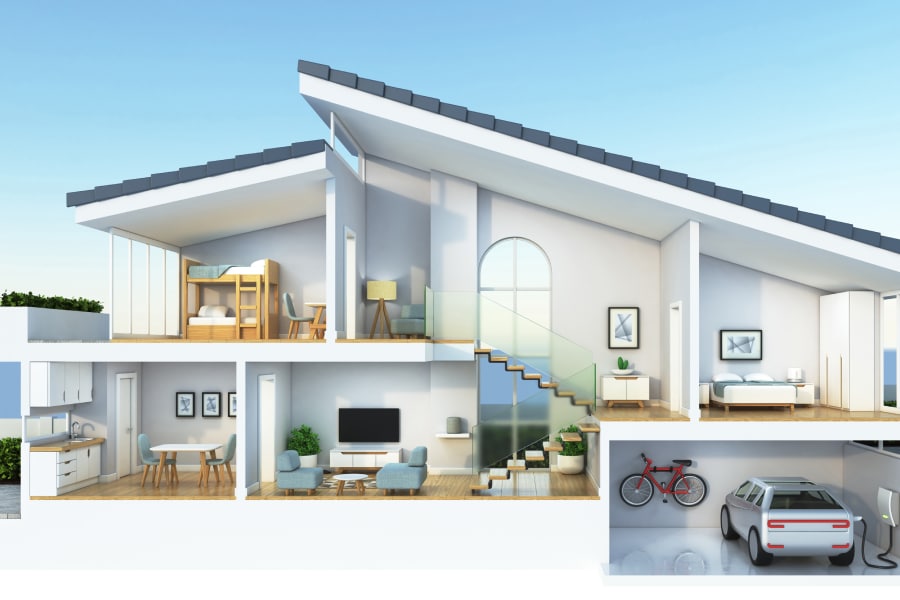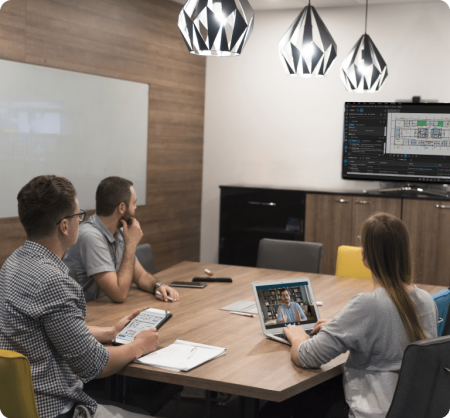When the builders of Crown Sydney, a 71-story, $2.2 billion skyscraper in Sydney, Australia, neared completion in early 2020, the team likely thought the hardest part of the project was safely behind it. All that remained was coordinating the skyscraper’s finishes—a complex phase given the building’s unique configuration that the team could accomplish from the comfort of nearby state-of-the-art offices.
Then came the COVID-19 pandemic, prompting country-wide lockdowns across the globe that sent most non-essential workers out of offices and into their homes, where they would work indefinitely.
The team members tasked with finishing Crown Sydney—which will become the city’s tallest building and includes a luxury hotel and apartments, as well as a casino, a shopping center and two rooftop decks fitted with infinity pools overlooking the horizon—were suddenly relegated to finishing the project on their laptops from home.
“It was quite difficult,” said Nick Smith, a structural engineer at Robert Bird Group, the engineering firm working on Crown Sydney. “You lose that face-to-face and human interaction.”
“It was like having a slight panic attack,” added Heike Hessenberger, an architect on the project with Bates Smart, describing the sudden work-from-home shift.
Construction industry media company The B1M, in partnership with Bluebeam, recently held a webinar panel discussion with these team members involved in finishing Crown Sydney from home due to the pandemic. The panel event came on the heels of The B1M’s premier of its film profiling Crown Sydney (above) and the project team’s unprecedented work-from-home challenge. Crown Sydney is scheduled to open in December 2020.
Moderated by Fred Mills, The B1M’s co-founder, the panel included the following team members:
- Heike Hessenberger, delivery architect, Bates Smart
- Kelly Furtado, regional director, APAC, Bluebeam
- Nick Smith, structural engineer, Robert Bird Group
Here are some highlights from the panel discussion:
Digital collaboration played a major role in the transition
Thankfully the team made the transition to an entirely digital way of working early on in the project’s lifecycle. So, when work suddenly had to shift from home, team members were already outfitted with most of the digital tools it would need to collaborate remotely.
“This really fast tracked [digital collaboration] at a much more personal level,” Smith said. “It enabled the project to continue working by looking at all the functionalities that Bluebeam has and saying, ‘How can we continue to improve it? It was working well before … but you really get to work on that efficiency when working from home.”
The project’s complex design forced the team early on to switch to an entirely paperless process. This ended up paying invaluable dividends when the shift to working from home happened.
“Now the initial review of changes to the building actually occur in Bluebeam,” Hessenberger said, “because of its ability to overlay drawings quite quickly.”
Full-time remote work is not ideal in construction
While other industries may emerge out of this year’s remote work experiment with a sense that it could become the new normal, the construction industry is one such industry where in-person, face-to-face interaction remains of upmost importance.
Obviously, field workers physically building a skyscraper such as Crown Sydney don’t have the option of working from home, but even for in-office roles such as engineer or architect, it’s clear that being together is important. This is especially the case in the final phases of a construction project, the panelists said.
“Not being able to witness some of these milestones with a team that you have worked with for many, many years was quite disappointing, but something you had to accept,” Hessenberger said of her remote-work experience. “To see the building growing and you just not being able to be out there during the whole process—it was tough to watch.”
Working from home helped further communication skills
Despite the obvious downsides to the architects and engineers on Crown Sydney having to work from home while completing the project, the panelists said the experience taught them to be more assertive when it comes to solving problems by asking for help from peers in the industry and Bluebeam user community. This is a lesson that construction professionals can take back to the in-office experience.
“Don’t dwell on something if you don’t know,” Hessenberger said. “Just go out there and ask someone. You will receive help.”
More digital collaboration means more from technology providers
As construction continues to move more toward an environment based on digital collaboration, the technology companies that provide the industry with the tools to get work done are going to be held to a higher standard.
As a result, the end-users of construction technology products—in the case of Crown Sydney, the architects and engineers, among others—need to communicate with their technology solution providers about new issues they may be encountering now that they’re operating in a more remote, digital-collaboration-focused world.
“Challenge your technology partners to deliver more for you,” said Kelly Furtado, Bluebeam’s director for the APAC region, “because we’re in a digital transformation sort of phase of the world. And part of our evolution as technology providers is listening to what our customers on these projects have to say so that we can deliver technology and solutions that work for the industry.”










